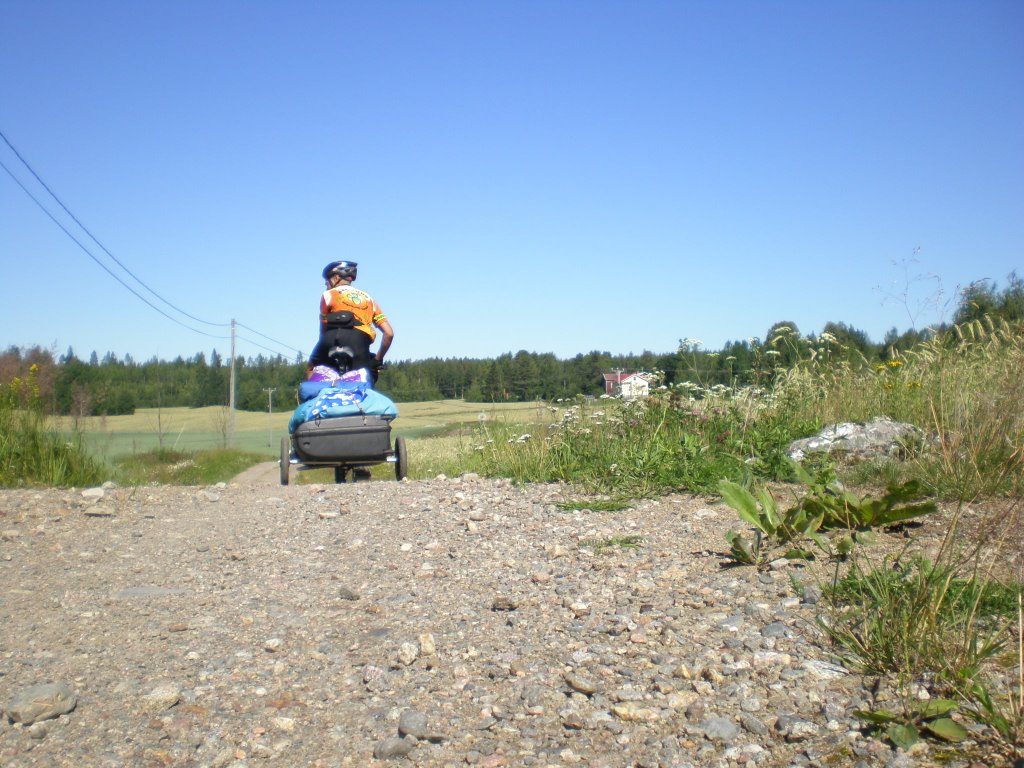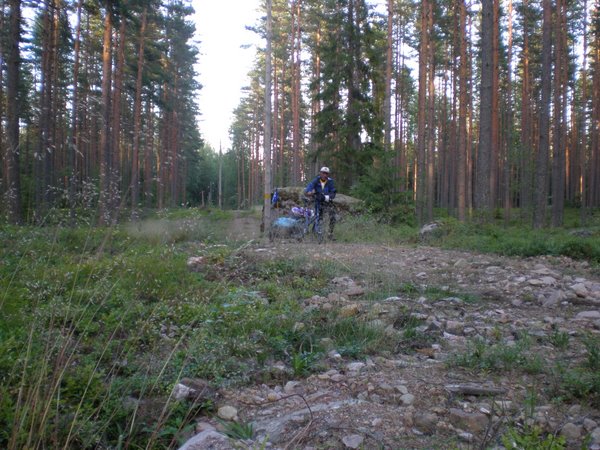In the morning, I am up at 6 am, quickly break camp and ride to a lonely spot of road where I was told I could catch the bus to the Sami town of Kautokeino. Once again, I dissemble the bike and wagon, then wait at this lonely outpost. I am joined by a young Norwegian man, also with a bike (not dissembled), who comfirms that I'm at the correct spot. At last a mini-bus pulls up. Three other Norwegian men and their bikes are already stuffed into the passenger compartment. If I had not taken my bike apart there would have been no room for me. The bus drives through a beautiful forested valley of tall Norwegian spruce and birch.
In the middle of the forest the driver stops the bus. We wait. She turns to me and explains in broken English that we are waiting for a Sämi woman, who will meet us at this spot. With all the bikes crammed into the aisle of the bus there is only one seat left.
"She will sit next to you," declares the driver. "You better hope she doesn't have a reindeer with her."
The woman does not have a reindeer. We are off again, climbing into a narrow canyon. The Alta River tumbles through a series of cataracts. I am reminded of the North Cascades. At the top of the canyon we emerge onto a broad plain that resembles Eastern Montana, a big grassy expanse with herds of reindeer scattered about and low mountains on the horizion. We let the cyclists off, and then the three of us continue to Kautokenio. The two women babble on.
"We are talking in Sämi," the driver tells me. "She was my neighbor when I lived in Kuatokenio. She has many reindeer. I drive a bus so I don't have reindeer."
I ask, "Does she know where your reindeer are?" The woman translates the English into Sämi.
"They are at the coast," she says via the driver.
I have this vision of reindeer basking in the sand at a luxury hotel at the coast. Then I remember what Hammerfest was like. The image dissipates.
There is more I want to ask, but the language barrier makes this difficult.
The bus driver lets the woman off at her house.
"What will you do in Kautokeino?
"I will put together my bike, then I might continue to Hetta in Finland or stay in Kautokeino. Right now I really would just rather take a nap. Do you have to drive back to Alta today?"
"Yes, but first I will go back to visit my friend. She has invited me over for coffee and fish. Besides, I still need to collect her fare."
The driver asks where I want to be let off. I wanted to tell her Helsinki, but settle for a block of buildings that constitute the village center. The driver bids me good-bye and I am left in a dusty parking lot with my two bags. I begin building the bike. This is truly the most Sämi of the villages I have visited, way off the tourist path. Indeed, I am next to the tourist office, which contains almost no tourist information. The sun is out, and for the first time in weeks I am actually warm. The Sämi go about their business while I assemble the bike. A man walks by in the traditional Sämi tunic. The village has the laconic feeling of a Navajo or Mexican village. No one seems to be in a big hurry. Everyone stops and greets another. The woman from the tourist office without tourist information, sits in a chair outside the building and watches me put my bike together piece by piece. At last the bike and wagon are assembled. I buy some food at the local store. I really would like to spend the night here, but it's only 1 pm. A hand written sign on the office of the local campground announces it is closed until 6 pm. Would-be customers are directed to a nearby blue house. I find the house and knock on the door. No one is home and it seems as if no one will be home for a very long time. The sun is out, a rarity in these parts, I decide to use the afternoon to make a dash back to Finland.
It has been awhile since I've cycled and my muscles cry out in protest. I slowly make my way across a treeless plateau. Storm clouds scuttle in from the north. Shortly before crossing the border back into Finland, at the 34 mile mark, I reach the 2,000th mile of my trip. A mile further is the tiny Sämi settlement of Tunturikeskus. I rent cabin that is built of thick, sturdy logs in the traditional Sämi style. While I am inside the office/cafe/reindeer shop, a man is eyeing my bike curiously. He asks where I've been and where I'm from.
"I am Sämi," he tells me by way of introduction.
"Do you have reindeer?"
"Oh yes, I have many reindeer."
"Where are they?" I am not so sure why I am so suddenly interested in knowing where everyone's reindeeer are. But it seems to be a good conversation starter in these parts. The Sämi seem eager to tell me whether they own reindeer. Besides, I have not seen any reindeer since I resumed pedalling. They were so abundant in their big herds yesterday. I wonder where they have gone.
"They are over there," he says, motioning to some vague place in the great fathomless plateau I've been slowly pedaling across. I look "over there" and see nothing. I realize "over there" might be a hundred miles away.
The storm hits during the night, but I am snug in my log house.


















